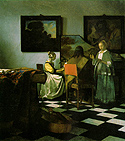Accused mobster, near death, denies ties to Boston art heist-lawyer
An accused
mobster on what may be his death bed once again denied knowing anything
about the whereabouts of paintings stolen from a Boston museum in the
largest art heist in U.S. history, his lawyer said on Saturday.
Robert
Gentile, 80, faces charges of selling a loaded firearm to a convicted
killer. His attorney contends the case was brought to pressure him into
leading federal agents to paintings stolen from Boston's Isabella
Stewart Gardner Museum in 1990.
Attorney
Ryan McGuigan said he visited Gentile in South Carolina this week after
being advised by federal officials to tell Gentile's wife, also 80 and
in ill health, and son, in his early 50s, to prepare for the possibility
of the man's death.
"I
told him that if there ever was a time to give up some information that
you haven't yet, that I don't know, this would be it," McGuigan said in a
phone interview. He said he believed that if Gentile were to offer up
new information about the paintings, federal officials would allow him
to see his family in Connecticut.
"He said, 'Yeah, but there's no
painting,'" McGuigan said. "His story has never changed in the six years
that I have represented him."
A
spokesman for federal prosecutors in Connecticut declined to comment.
McGuigan said he could not provide more detail on where Gentile is being
held.
Gentile had been
due to stand trial last month on the gun charge, but his failing health
delayed proceedings. He has repeatedly denied knowing the whereabouts of
any of the art taken in one of the longest-unsolved high-profile crimes
in Boston.
The
theft was carried out by two men dressed in police uniforms who
apparently overpowered a night security guard who had buzzed them in a
back entrance. None of the 13 artworks, which include Rembrandt's "Storm
on the Sea of Galilee" and Vermeer's "The Concert," has been recovered.
Due
to a quirk in Gardner's will, the empty frames that held the paintings
remain on the walls of the museum she built to house the collection she
amassed with her husband.
The
art must be displayed the way it was during her lifetime, preventing
curators from hanging new works and leaving a constant reminder of the
theft.
At a court hearing last year,
federal prosecutors said Gentile was secretly recorded telling an
undercover FBI agent he had access to at least two of the paintings and
could sell them for $500,000 each.
A
2012 FBI search of Gentile's home turned up a handwritten list of the
stolen art, its estimated value and police uniforms, according to court
documents.
Art Hostage Comments:
What Bobby Gentile's Lawyer, Attorney
Ryan McGuigan, fails to reveal is the signed deal he has with his client Bobby Gentile, giving him personally at least 40% of the $5 million reward if the Gardner paintings are ever recovered.
Bobby Gentile knows this full well and therefore, he might pass away without revealing what he actually knows about the whereabouts of the Gardner art.
However, I am sure Bobby Gentile has made provisions for his nearest and dearest to have those facts, so they may be in a position to utilise them after Bobby Gentile leaves this mortal coil.
Whether the remaining members of the Gentile family are bound by the signed agreement between Bobby Gentile and Attorney
Ryan McGuigan remains to be seen, but the 40% plus demands of
Attorney
Ryan McGuigan could be counter productive and be the very reason why Bobby Gentile, or his family would not be willing to expose themselves to Law Enforcement scrutiny in pursuit of the Gardner art reward.


4 comments:
It's bad news any way you look at it. Either he had some of the art and it got ruined in the flood under the shed, or he knows where the art is and he's taking the secret to the grave, or he never did know where the art was and had always been an opportunist who couldn't produce. I worry that the truth is option 1, and he's too embarrassed to give up that information - especially since ruined art would not lead to the reward.
It's bad news any way you look at it. Either he had some of the art and it got ruined in the flood under the shed, or he knows where the art is and he's taking the secret to the grave, or he never did know where the art was and had always been an opportunist who couldn't produce. I worry that the truth is option 1, and he's too embarrassed to give up that information - especially since ruined art would not lead to the reward.
What about Arthur Brand? Is he any closer with his Irish lead?
Arthur Brand said a Dutch criminal had photo's of the Gardner and was trying to sell them in Europe back in the 1990's.
This was Michel Van Rijn, who sold them to Irish drug dealers who work out of the Netherlands. Trouble is they were copies/fakes, which the buyers could not get authentiucated for obvious reasons, and since then they have been passed through many hands. The so called leads Arthur brand has is current drug dealers working from Netherlands who claim they were ex-IRA, which may or may not be true, but might be a claim used for kudos. If and when these copies surface it will quickly be determind they are fakes and Michel Van Rijn was scamming the Irish buyers with fakes.
Post a Comment